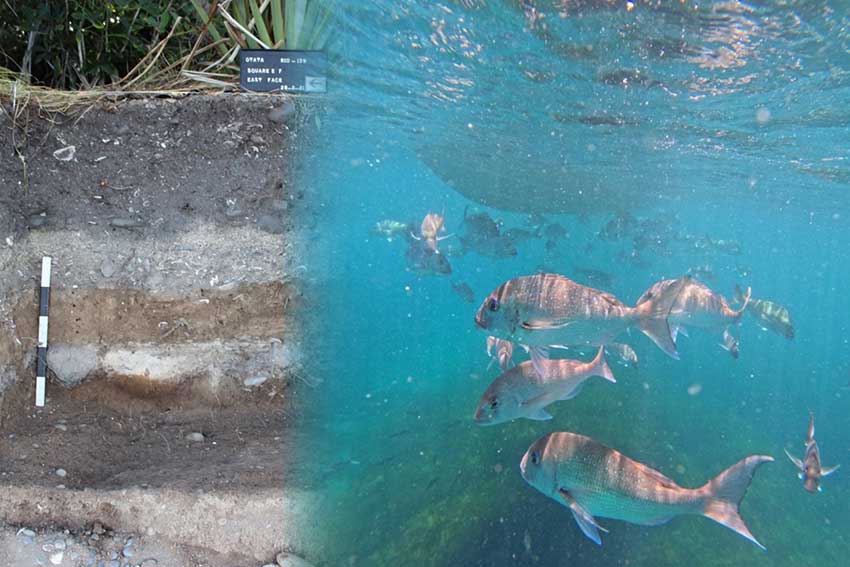Shift in NZ snapper behaviour

An international team of scientists, led by Auckland University of Technology (AUT), has uncovered a dramatic shift in the movement patterns of New Zealand’s snapper (Chrysophrys auratus) that coincided with New Zealand’s Industrial Revolution. The study identifies the 19th century as a critical tipping point, reshaping how snapper utilized their habitats in response to widespread environmental changes.
Focusing on the SNA1 stock—a spatially distinct snapper population spanning the upper east coast of New Zealand, including the Hauraki Gulf—the research reveals a striking contrast between pre-industrial and modern snapper behaviour. For centuries, snapper relied on low-salinity estuarine nurseries, which provided stable and essential habitats for juvenile development. However, industrialization and environmental degradation have disrupted these ecosystems, forcing snapper into high-salinity marine environments.
Otoliths: A Window into the Past
Central to the study was the analysis of otoliths, or fish ear bones, which are formed layer by layer as fish grow. These layers capture the chemical composition of the waters the fish inhabited, making otoliths valuable biological archives. The elemental signatures within otoliths can reflect the salinity, temperature, and other environmental conditions of the surrounding waters. By analysing these chemical profiles, the team reconstructed centuries of snapper movement and habitat use.
“The chemical composition of otoliths acts like a diary, recording the environments fish experienced throughout their lives,” explained Dr Julian Lilkendey from AUT. “This allowed us to trace how snapper habitat-use has shifted over time.”
Reconstructing Paleao-Behaviours Through Collaboration
This research was made possible through the combined efforts of marine ecologists from AUT, along with chemists, anthropologists, and archaeologists from the University of Otago and Auckland War Memorial Museum. Radiocarbon dating of charcoal and other organic materials found in Māori middens - ancient trash heaps - was used to establish a timeline for environmental changes. These middens, containing fish remains and otoliths, serve as a unique archive of historical marine ecosystems.
“The midden contexts, together with historical fishery surveys and modern recreational fisher samples, allowed us to connect chemical profiles from otoliths to specific time periods,” said Dr Lilkendey. “This approach enabled us to pinpoint exactly when snapper movement patterns shifted in response to environmental pressures.”
Dynamic Time Warping: Cutting-Edge Analysis
The team employed dynamic time warping, an algorithm originally developed for speech recognition, to align continuous chemical data from laser ablated transects on the otoliths. This novel application of DTW, conducted in collaboration with Dr Jens Hegg from Gonzaga University (Spokane, USA), enabled precise comparisons of snapper habitat use over time.
“Dynamic time warping is an incredibly powerful tool,” Dr Lilkendey noted. “This very method allowed us to identify subtle shifts in habitat use encoded in otolith chemistry, even across individuals with differing growth rates and environmental exposures.”
Successfully Revitalising the Hauraki Gulf May Require Information from the Past
The study’s findings highlight the dramatic changes in snapper habitat use over centuries. Before the Industrial Revolution, snapper movement patterns were stable, with juveniles relying on estuarine nurseries as critical developmental habitats. However, by the 19th century, increasing sedimentation and pollution caused by human activities degraded these environments, pushing snapper into less favourable high-salinity marine habitats.
“We see clear evidence of a turning point in the 19th century,” said Associate Professor Armagan Sabetian of AUT. “The loss of estuarine habitats aligns closely with industrialization and the accompanying intensification of human impacts on the coastal environment.”
The findings have significant implications for conservation initiatives like the New Zealand government’s Revitalising the Hauraki Gulf programme. By establishing historical baselines for snapper movement behaviours, the study offers critical benchmarks for restoration and management.
“Understanding how snapper historically used their habitats and how this is encoded in their otoliths enables us to set meaningful targets for recovery,” Dr Sabetian added. “By aligning snapper movement behaviour with pre-industrial baselines, we can be confident that the environmental conditions necessary to support these behaviours are being restored. This knowledge is essential for reversing habitat degradation, restoring ecological resilience, and enabling our coastal ecosystem to function properly again.”